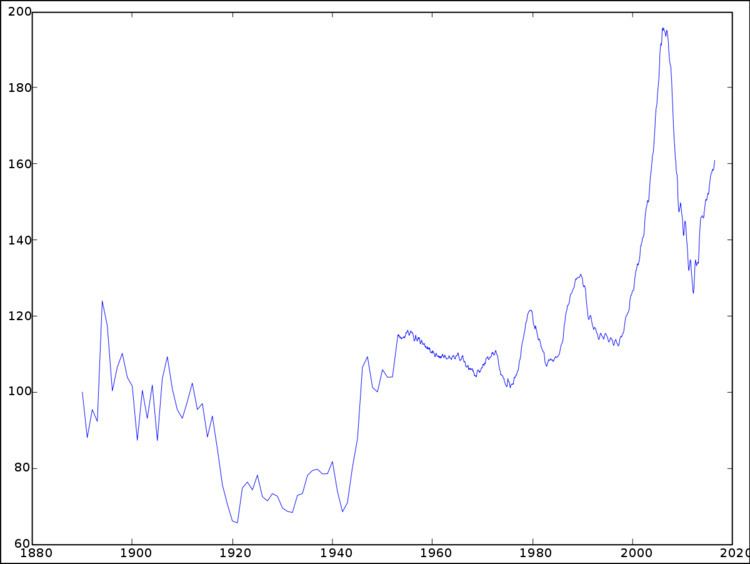 | ||
A House Price Index (HPI) measures the price changes of residential housing. Methodologies commonly used to calculate HPI are the hedonic regression (HR), simple moving average (SMA) and repeat-sales regression (RSR).
Contents
FHFA/OFHEO
The US Federal Housing Finance Agency (formerly Office of Federal Housing Enterprise Oversight a.k.a. OFHEO) publishes the HPI inx, a quarterly broad measure of the movement of single-family house prices.
The HPI is a weighted, repeat-sales index, meaning that it measures average price changes in repeat sales or refinancings on the same properties in 363 metropolises. This information is obtained by reviewing repeat mortgage transactions on single-family properties whose mortgages have been purchased or securitized by Fannie Mae or Freddie Mac since January 1975.
Since the HPI index only includes houses with mortgages within the conforming amount limits, the index has a natural cap and does not account for jumbo mortgages.
The HPI was developed in conjunction with OFHEO's (now FHFA) responsibilities as a regulator of Fannie Mae and Freddie Mac. It is used to measure the adequacy of their capital against the value of their assets, which are primarily home mortgages.
On July 30, 2008 OFHEO became part of the new Federal Housing Finance Agency (FHFA). The index is now termed the FHFA HPI.
S&P/Case-Shiller Indices
The Case-Shiller index prices are measured monthly and tracks repeat sales of houses using a modified version of the weighted-repeat sales methodology proposed by Karl Case and Robert Shiller and Allan Weiss. This means that, to a large extent, it is able to adjust for the quality of the homes sold, unlike simple averages.
As a monthly tracking index, Case-Shiller Index has long lag time. Typically, it takes about 2 months for S&P to publish the results, as opposed to 1 month for most other monthly indices and indicators. Specific indexes are available for specific metropolitan areas, and composite indexes for the top 20 and top 10 metro areas, and nationwide.
FNC Residential Price Index
FNC Inc. publishes the Residential Price Index, which is based on data collected from public records blended with data from real-time appraisals of property and neighborhood attributes. The RPI is the mortgage industry's first hedonic price index for residential properties. The RPI is constructed to gauge price movement among non-distressed home sales, and excludes sales of foreclosed properties.
As a monthly tracking index, the RPI has a lag time of about two months. Specific indices are available for specific metropolitan areas, and composite indices are available for the top 10, 20, 30, and 100 metro areas. The RPI is also available at the zip code level and can be constructed to track price trends for specific characteristics (e.g., ranch-style house, colonial-style house, etc.) since preferences can change over time.
United Kingdom
House Price Indices (HPIs) have been produced in the UK since around 1973, initially by mortgage-providers, and more recently by government bodies. More recently, they have come from property market websites. Currently, house prices are increasing strongly across most parts of the UK, with prices in London showing the highest growth. UK house prices increased by 10.5% in the year to May 2014, up from 9.9% in the year to April 2014.
Governmental house price indices
Private sector house price indices
Ireland
In the Republic of Ireland, Permanent TSB (a large mortgage lender) and the Economic and Social Research Institute (a think-tank) have published a monthly houseprice index since January 1996.
India
In India, National Housing Bank completely owned by Reserve Bank of India computes an index termed NHB RESIDEX. The index was formulated based on a pilot study covering 5 cities, Delhi, Mumbai, Kolkata, Bangalore and Bhopal representing the five regions of the country. Actual transactions prices are used to compute an Index reflecting the market trends. 2007 is taken as the base year for the study to be comparable with the WPI and CPI. It now covers Delhi with NCR, Bangalore, Mumbai, Kolkata, Bhopal, Hyderabad, Faridabad, Patna, Ahmedabad, Chennai, Jaipur, Lucknow, Pune, Surat, Kochi, Bhubaneshwar, Guwahati, Ludhiana, Vijayawada, Indore, Chandigarh, Coimbatore, Dehradun, Meerut, Nagpur and Raipur. The index shows that the prices have doubled in cities like Mumbai, Delhi and Bhopal, but have declined in Hyderabad and Kochi.
Canada
In Canada, the New Housing Price Index is calculated monthly by Statistics Canada. Additionally, a resale house price index is also maintained by the Canadian Real Estate Association, based on reported sale prices submitted by real estate agents, and averaged by region. In December 2008, the private National Bank and the information technology firm Teranet began a separate monthly house price index based on resale prices of individual single-family houses in selected metropolitan areas, using a methodology similar to the Case-Shiller index and based on actual sale prices taken from government land registry databases. This allows Teranet and the National Bank to track prices without allowing periods of high sales in one city to push up the national average. The National Bank also operates a forward market on Canadian housing prices.
